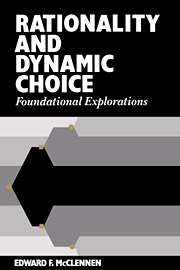Book contents
- Frontmatter
- Contents
- Conditions on orderings and acceptable-set functions
- Acknowledgments
- 1 Introduction and sketch of the main argument
- 2 The ordering principle
- 3 The independence principle
- 4 The problem of justification
- 5 Pragmatic arguments
- 6 Dynamic choice problems
- 7 Rationality conditions on dynamic choice
- 8 Consequentialist constructions
- 9 Reinterpreting dynamic consistency
- 10 A critique of the pragmatic arguments
- 11 Formalizing a pragmatic perspective
- 12 The feasibility of resolute choice
- 13 Connections
- 14 Conclusions
- 15 Postscript: projections
- Notes
- Bibliography
- Author index
- Subject index
3 - The independence principle
Published online by Cambridge University Press: 05 February 2012
- Frontmatter
- Contents
- Conditions on orderings and acceptable-set functions
- Acknowledgments
- 1 Introduction and sketch of the main argument
- 2 The ordering principle
- 3 The independence principle
- 4 The problem of justification
- 5 Pragmatic arguments
- 6 Dynamic choice problems
- 7 Rationality conditions on dynamic choice
- 8 Consequentialist constructions
- 9 Reinterpreting dynamic consistency
- 10 A critique of the pragmatic arguments
- 11 Formalizing a pragmatic perspective
- 12 The feasibility of resolute choice
- 13 Connections
- 14 Conclusions
- 15 Postscript: projections
- Notes
- Bibliography
- Author index
- Subject index
Summary
Alternative formulations of independence
The weak ordering principle discussed in the preceding chapter pertains to the ranking of any set of alternatives, regardless of the nature of the alternatives themselves. The second of the cornerstones of the modern theory of utility and subjective probability, the independence principle, is more specialized. As formulated in Chapter 1, it places the following restriction on the ordering of options that involve risk or uncertainty (in suitably defined senses of each of these terms):
Independence (IND). Let g1, g2, and g3, be any three alternative gambles. Then g1R g2 iff g13 = [g1, p; g3, 1 - p] R g23 = [g2, p; g3, 1 - p],
where gij = [gi, p; gj, 1 - p] is a complex gamble in which there is p probability of being exposed to the gamble gi and 1 - p probability of being exposed to gj, and 0 < p ≤ 1.
IND invites further extension and/or specialization in a variety of ways. By way of illustration, note first of all that since an outcome involving no risk (a “sure” outcome) can be viewed as a “gamble” in which one gets that outcome with probability 1, IND yields a constraint on preference in the special case of gambles whose component outcomes themselves involve no risk:
Independence for sure outcomes (ISO). Let o1, o2, and o3 be any three outcomes (monetary prizes, etc.). […]
- Type
- Chapter
- Information
- Rationality and Dynamic ChoiceFoundational Explorations, pp. 44 - 59Publisher: Cambridge University PressPrint publication year: 1990

